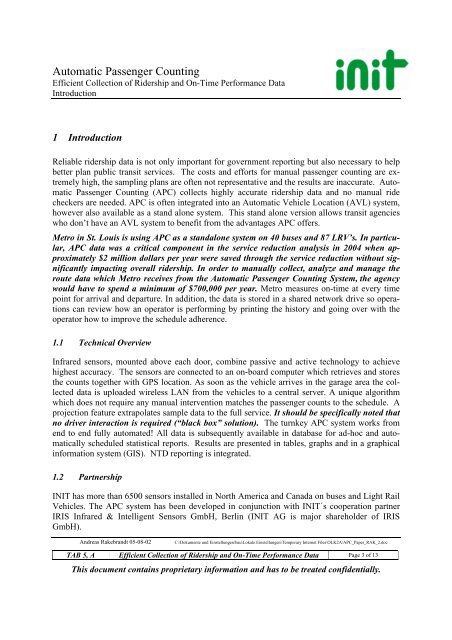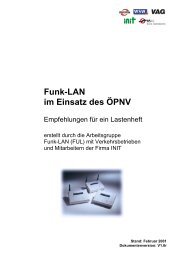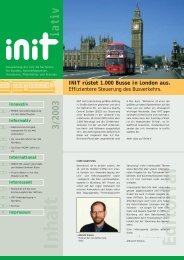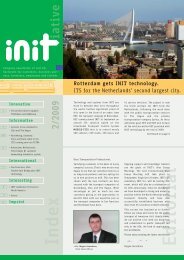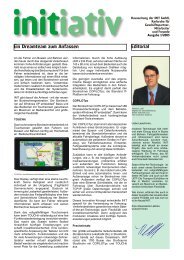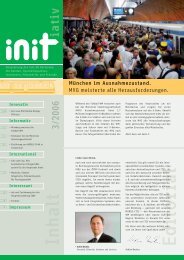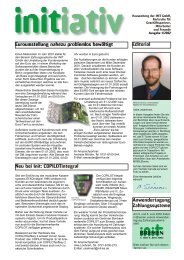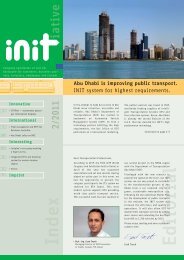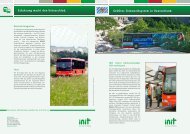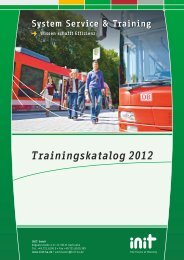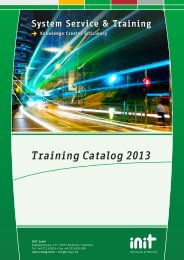Efficient Collection of Ridership and On- Time Performance Data - Init
Efficient Collection of Ridership and On- Time Performance Data - Init
Efficient Collection of Ridership and On- Time Performance Data - Init
You also want an ePaper? Increase the reach of your titles
YUMPU automatically turns print PDFs into web optimized ePapers that Google loves.
Automatic Passenger Counting<br />
<strong>Efficient</strong> <strong>Collection</strong> <strong>of</strong> <strong>Ridership</strong> <strong>and</strong> <strong>On</strong>-<strong>Time</strong> <strong>Performance</strong> <strong>Data</strong><br />
Introduction<br />
1 Introduction<br />
Reliable ridership data is not only important for government reporting but also necessary to help<br />
better plan public transit services. The costs <strong>and</strong> efforts for manual passenger counting are extremely<br />
high, the sampling plans are <strong>of</strong>ten not representative <strong>and</strong> the results are inaccurate. Automatic<br />
Passenger Counting (APC) collects highly accurate ridership data <strong>and</strong> no manual ride<br />
checkers are needed. APC is <strong>of</strong>ten integrated into an Automatic Vehicle Location (AVL) system,<br />
however also available as a st<strong>and</strong> alone system. This st<strong>and</strong> alone version allows transit agencies<br />
who don’t have an AVL system to benefit from the advantages APC <strong>of</strong>fers.<br />
Metro in St. Louis is using APC as a st<strong>and</strong>alone system on 40 buses <strong>and</strong> 87 LRV’s. In particular,<br />
APC data was a critical component in the service reduction analysis in 2004 when approximately<br />
$2 million dollars per year were saved through the service reduction without significantly<br />
impacting overall ridership. In order to manually collect, analyze <strong>and</strong> manage the<br />
route data which Metro receives from the Automatic Passenger Counting System, the agency<br />
would have to spend a minimum <strong>of</strong> $700,000 per year. Metro measures on-time at every time<br />
point for arrival <strong>and</strong> departure. In addition, the data is stored in a shared network drive so operations<br />
can review how an operator is performing by printing the history <strong>and</strong> going over with the<br />
operator how to improve the schedule adherence.<br />
1.1 Technical Overview<br />
Infrared sensors, mounted above each door, combine passive <strong>and</strong> active technology to achieve<br />
highest accuracy. The sensors are connected to an on-board computer which retrieves <strong>and</strong> stores<br />
the counts together with GPS location. As soon as the vehicle arrives in the garage area the collected<br />
data is uploaded wireless LAN from the vehicles to a central server. A unique algorithm<br />
which does not require any manual intervention matches the passenger counts to the schedule. A<br />
projection feature extrapolates sample data to the full service. It should be specifically noted that<br />
no driver interaction is required (“black box” solution). The turnkey APC system works from<br />
end to end fully automated! All data is subsequently available in database for ad-hoc <strong>and</strong> automatically<br />
scheduled statistical reports. Results are presented in tables, graphs <strong>and</strong> in a graphical<br />
information system (GIS). NTD reporting is integrated.<br />
1.2 Partnership<br />
INIT has more than 6500 sensors installed in North America <strong>and</strong> Canada on buses <strong>and</strong> Light Rail<br />
Vehicles. The APC system has been developed in conjunction with INIT´s cooperation partner<br />
IRIS Infrared & Intelligent Sensors GmbH, Berlin (INIT AG is major shareholder <strong>of</strong> IRIS<br />
GmbH).<br />
Andreas Rakebr<strong>and</strong>t 05-08-02<br />
C:\Dokumente und Einstellungen\bau\Lokale Einstellungen\Temporary Internet Files\OLK2A\APC_Paper_RAK_2.doc<br />
TAB 5, A <strong>Efficient</strong> <strong>Collection</strong> <strong>of</strong> <strong>Ridership</strong> <strong>and</strong> <strong>On</strong>-<strong>Time</strong> <strong>Performance</strong> <strong>Data</strong> Page 3 <strong>of</strong> 13<br />
This document contains proprietary information <strong>and</strong> has to be treated confidentially.


